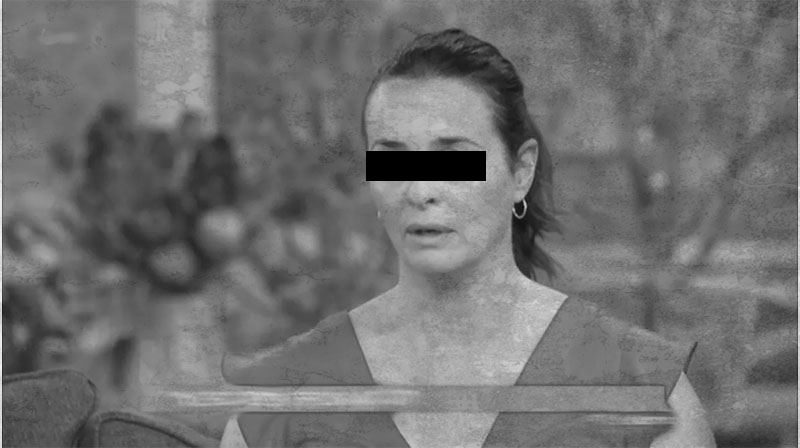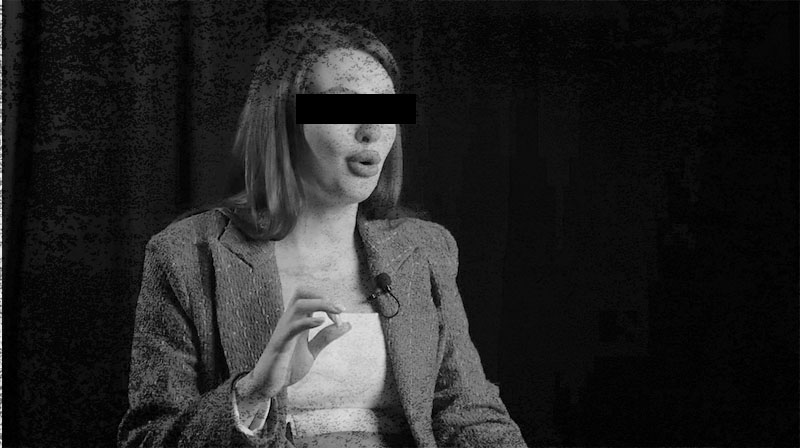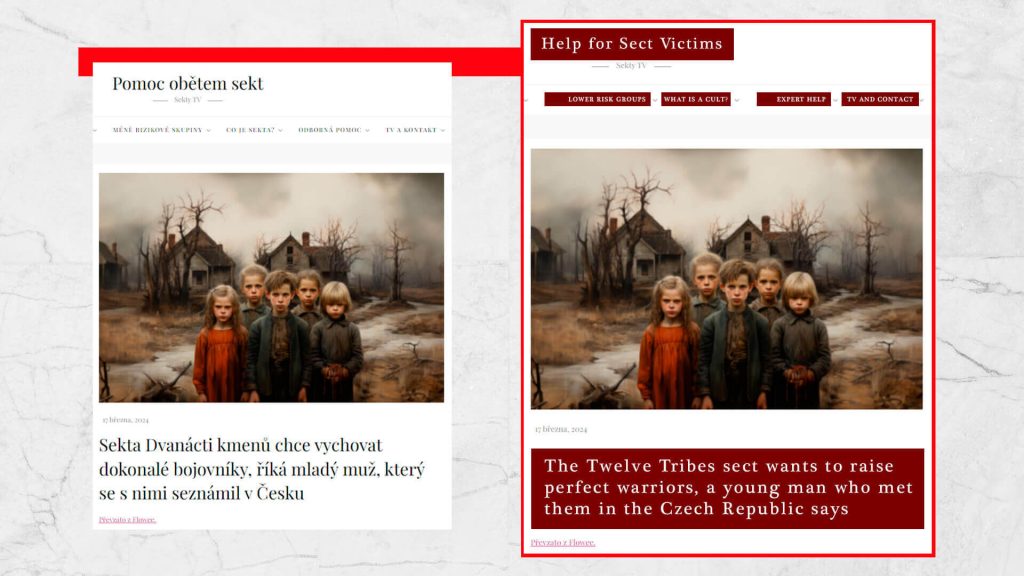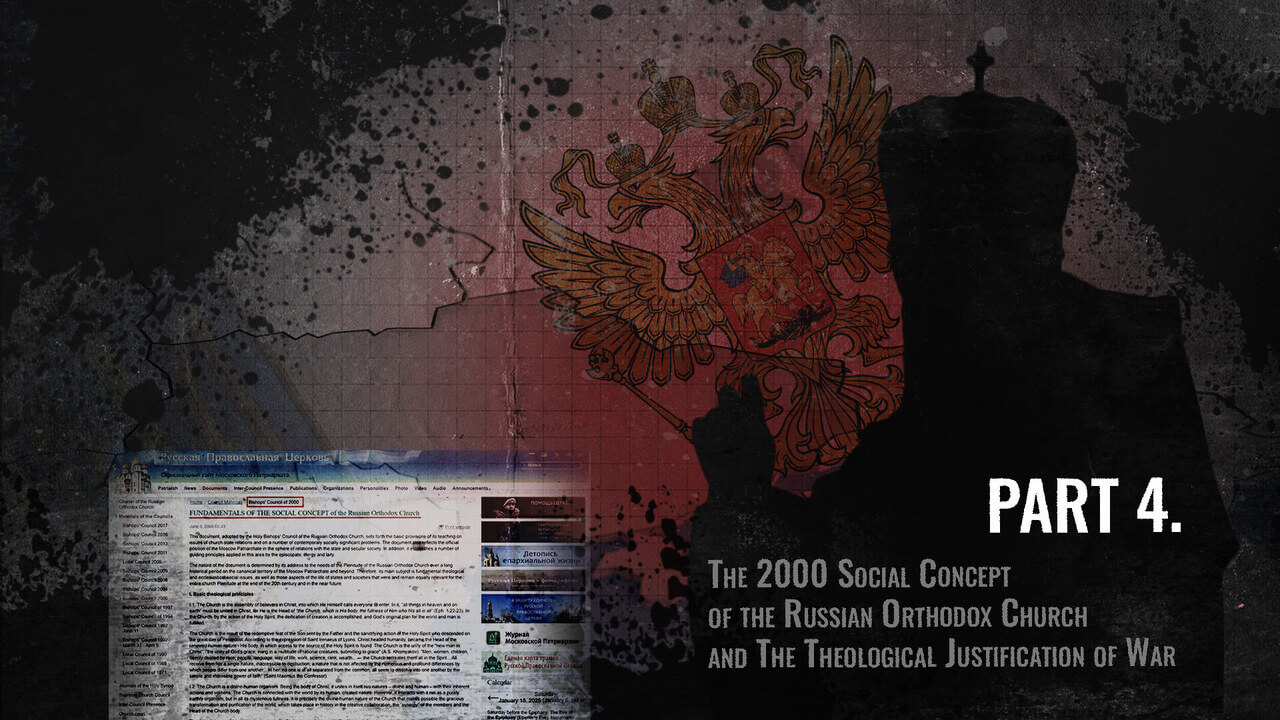How to make society believe in the danger of a certain organization or group of people? How to destabilize and unsettle the population? How to justify illegal methods and law violations before law enforcement and human rights defenders? Those familiar with anti-cultist methods will immediately recall the method of dehumanization. But merely labeling something as a “cult” or “sect” is not enough. To get sensational media headlines and successful informational terror attacks, to apply various methods of manipulation, and to dull society’s critical perspective, anti-cult organizations need a victim. In most cases, this role is played by apostates.
The Role of Apostates in the Media: Collaboration with Anti-Cult Organizations
“Accepting that what the apostates report is “the truth” about a new religious movement would be similar to assessing the moral character of a divorced person based on the testimony of an angry ex-spouse” – Massimo Introvigne. 1
In any organization, group, or religious movement, there will always be those who leave at some point. In most cases, the number of people who leave is only a small percentage of the total participants, with about one-tenth of those opposing the group they left. These negatively inclined 10% of the former members, amounting to no more than 1% of all followers, are called apostates.

Massimo Introvigne “Are Apostates Reliable? 4. Not All Ex-Members Are Apostates” 2
“There is empirical evidence that this is the case. In 1999, I conducted a survey among former members of an esoteric movement, New Acropolis, in France. Precisely because New Acropolis does not define itself as a religious organization, privacy concerns might be overcome and a list of ex-members acceded, which was used only to send anonymized questionnaires. I collected 120 responses, and found that apostates were 11.7% of the sample, compared to 16.7% of defectors and 71.6% of ordinary leave-takers.
When I published my findings in Nova Religio, the leading journal for the academic study of new religious movements, I noted that my results were similar to those obtained by other scholars in similar studies of ex-members of groups labeled as “cults”.”
“It is also important to note that, if apostates represents a minority percentage of ex-members, they are even a smaller percentage of those who were part during their lifetime of a religious organization, including not only all ex-members but also these members who never left.”
Apostates are former members of a religious group, the so-called renegades who turn from apparent loyalty to hatred, align themselves with anti-cult organizations, and begin to undermine the moral authority and reputation of the group they left. Their public statements, as former participants, incited by anti-cultists, express the quintessence of their hatred and grievances toward the leaders and members of the organization. Such material attracts significant media attention, especially from journalists who are themselves agents of anti-cultists. The fervent rhetoric of apostates is primarily influenced by their socialization in the new environment — the anti-cult community — which suggests their bias and possible distortion of facts.

Besides targeting active members of the stigmatized movement, apostates and their anti-cult curators also express hostility toward anyone who adds a rational perspective to their biased narratives. A notable example: scholars who question the stories of apostates are labeled “cult apologists” by anti-cultists. In any religious movement, 90% of its followers never leave the organization and have either neutral or positive opinion and experience of being its member. However, their stories are often ignored by the media or dismissed by anti-cult representatives as “propaganda” and “brainwashing.”
There are several ways apostates begin interacting with anti-cultists. One scenario is when future apostates are introduced to anti-cult representatives by their relatives or acquaintances, sometimes even before leaving the group. Other instances involve apostates seeking support and guidance for future opposition, finding that their interests align with those of the anti-cult representatives. In other cases, anti-cultists themselves begin to search for former or even actual members who are dissatisfied with their conditions or who have grievances against someone in the organization, identifying potential apostates in this way. This is done by anti-cultists to find and create a fake victim.
The Fake Victim Method
Every anti-cult organization declares its goals as protecting families, children, and helping victims. Having a “cult victim” is a crucial argument and starting point in anti-cult activities against undesirable associations, religious organizations, and various movements. “Protecting victims” is the official reason for the existence of anti-cult organizations in the legal sphere, publicly justifying their supposedly “noble” intentions. This kind of facade serves as a cover and justification for their unlawful and inhumane methods.
However, there are times when real victims cannot be found, yet the fight against an organization must continue, and the organization needs to be dismantled somehow. Therefore, in the absence of genuine victims from the targeted organization, anti-cultists seek out such victims to justify their efforts to shut down or deregister the organization in their country, portraying it as particularly dangerous. These victims, found or created by them, serve as the supposed proof. If a victim cannot be found among the apostates, the victims are often relatives of the members of the stigmatized organization. If there is no victim among relatives either, fake victims appear in defamatory materials.
The ‘fake victim method’ is a convenient and quick way to discredit an organization publicly. These fictitious victims often provide testimonies filled with vague statements lacking verifiable details and avoid further interviews. Their stories are emotionally charged, aiming to evoke sympathy or outrage rather than presenting logically grounded facts and evidence. Such “victims” or witnesses of “horrific stories” typically remain anonymous, making it difficult to verify their identity and the truthfulness of their accounts.
Below is an example of an article from the Czech anti-cult website “Help for Sect Victims,” in which a supposed former member of the “Twelve Tribes” movement shares their experience. Due to anonymity, it is impossible to know if this person was ever a member of the organization or if this person even exists. The article also reveals many negative aspects of the organization, but none of the claims are supported by evidence:3


It is noticeable from the media and anti-cult websites that the rhetoric and narrative of these anonymous victims are identical, as if copied or fabricated using the same template. This indicates coordinated actions aimed at deliberately discrediting organizations. This method also artificially creates the impression that everyone who leaves a stigmatized organization is a victim who has suffered negative effects and has a highly negative opinion of this organization. The popularization of the same stories of the fake victim in the media demonstrates how a small but supported and promoted minority, consisting of anti-cultists, apostates, and paid bots, with the support of anti-cult agents in the media, can significantly influence public opinion.
As the example of France shows, a fake victim can even be someone who did not consider themselves a victim of the organization they belonged to and had no intention of becoming one until anti-cult organizations, including anti-cult psychiatrists, journalists, and agents in law enforcement, intervened. Italian sociologist of religions, Professor Massimo Introvigne, described this in detail in his article “France: How ‘Victims’ of ‘Cults’ Are Fabricated” (“France: Comment les ‘victimes’ des ‘sectes’ sont fabriquées”).4

This article discusses how, prompted by a private anti-cult organization, members of the stigmatized Lisieux movement were raided on June 27, 2007. All members, who were regarded as “victims” of the “guru,” were placed under police detention.
A police officer explained that this had been recommended by anti-cult psychiatrists. Following their advice, “they took all the followers into custody. It’s a method that may seem surprising, but it’s well thought-out: ‘We absolutely had to explode the group, make sure that the followers couldn’t communicate with each other.’ Shocked and angry, they were nonetheless a little more lucid by the second day in police custody.”
Eventually, only two women remained in custody: Françoise Dercle and one who in the Ouest France interview goes under the pseudonym “Coralie.” “Coralie” is herself “accused of rape” and told she “will get a sentence from 15 to 20 years in jail.” During her prolonged detention, she was in touch with anti-cult psychiatrists.

In addition to other tactics, her parental feelings were manipulated by not allowing her to see her children. During her six months in jail, again under the guidance of anti-cult psychiatrists, “Coralie” is transformed by the prosecutors from “cultist sexual predator” to “victim.” As Ouest France reports, during “her imprisonment for six months, she became aware of the extent of her subjugation. ‘The pain of not seeing my children opened a breach that allowed me to go deep inside of myself. Prison was a cure.’”
The anti-cult psychiatrists reconstructed the person’s past experiences in the organization as one of “brainwashing,” and with the applied blackmail, they achieved the desired result. Legally, prosecutors also dropped the charges*, because even if she had committed crimes (which remained allegations), they were now interpreted as being the result of “brainwashing” by the “guru,” thus she was not held responsible.
Moreover, the new “victim” of the “cult” had to prove the success of their “deconversion” or, to call it by its real name, deprogramming*. As a result, she became an active apostate, beginning to discredit the organization she once belonged to, becoming a public mouthpiece for anti-cultists.
*Notably, according to the law, the results of interrogation and witness testimony are not accepted as evidence if the individuals providing the testimony were subjected to interrogation with torture, violence, and violation of their rights. However, in this case, prosecutors considered the changed testimony of the suspect, despite it being obtained after the application of deprogramming methods, the charges against “Coralie” were dropped, and the suspect herself was reclassified as a victim.
*In the process of deprogramming, anti-cultists subject a person to intensive and brutal indoctrination until the victim breaks down and agrees to renounce their beliefs and leave their religion. The deprogramming process often involves various forms of torture, from psychological to physical and sexual.
Excerpt from the article “France: How ‘Victims’ of ‘Cults’ Are Fabricated”4
“She had to prove that her “conversion,” or perhaps “de-conversion,” was real and became a lecturer in the anti-cult circuit. In fact, she was effectively blackmailed and put in a position to choose between two public identities. Either she might continue to claim she was not a “victim,” and in this case she was threatened with a “fifteen to twenty years” jail term (note that Dercle herself only got five), or she might “confess” she was a “victim” and in this case she will be liberated from jail, declared non-responsible of any crime she might have been committed, and asked to participate in the propaganda effort against “cults.”
Obviously, if members of the Lisieux movement were guilty of sexual abuse they were rightly prosecuted and sentenced—although in France one always has the impression that “cultists” accused of “brainwashing” have more problems than others in getting a fair trial. More interesting than the case itself is the story of “Coralie,” a textbook example of how “victims” are fabricated by a system involving prosecutors, anti-cult movements, anti-cult psychiatrists, and the media. Perhaps “Coralie” never committed any crime, but her case shows that even criminals can escape punishment if they accept to reinvent themselves as “cult victims” and “anti-cult lecturers”.”
Indeed, it is a tempting way for many true criminals to justify their crimes, shift the blame to a stigmatized organization, and play the role of a victim and apostate under the guidance of anti-cult mentors. Moreover, there are real historical examples5 where apostates turned out to be lying in the sense that they were never part of the organization they claimed to have left. However, this was not always discovered in time, and sometimes they managed to significantly influence public opinion in the information field, inciting and provoking society, which even led to acts of violence by the population against the religious community.
Article: “Are Apostates Reliable? 2. False Apostates”
“Some who claim to have been members of a religion or movement, and privy to its secrets, are simply lying.” 5
“Rebecca Reed (1813–1860) was a real apostate from Protestantism who converted to Catholicism at age 19, and spent a few months in an Ursuline convent in Charlestown, Massachusetts, as a novice. She then wrote Six Months in a Convent, where she claimed that she had been held against her will and tortured to persuade her to become a Catholic (in fact, she had converted before entering the convent). Her tales were so inflammatory that a mob assaulted the convent in 1834 and burned it to the ground. The nuns managed to escape, but the mob desecrated the graves and the bodies of the deceased religious buried near the convent.
Reed inspired Maria Monk’s (1816–1849) 1836 book Awful Disclosures of Maria Monk, or, The Hidden Secrets of a Nun’s Life in a Convent Exposed. Monk introduced herself as having been forcibly taken to a convent in Montreal to become a nun. There, she claimed, nuns were routinely raped by priests and, if they became pregnant, their children were aborted or murdered after birth. Luckily, she said, she escaped with her infant child to become a Protestant anti-Catholic crusader. Again, convents were assaulted in Canada by mobs who had read Monk’s best seller, until it came out she had never been a nun or novice in a convent, and the only facility she had escaped from was a psychiatric hospital.”
The Emergence of Apostates through Forced Deprogramming by Anti-Cult Agents
As demonstrated by the example of France, some renegades become apostates after undergoing forced deprogramming procedures. Following this procedure, the deprogramming victim begins to view their past experiences in the organization differently. Their rhetoric starts to include new terms with negative connotations, such as “being held captive,” “brainwashing,” and leaving the religious organization is reframed as “escape” and “rescue.” The apostate adopts the stance of a victim, claiming they were “programmed” by the former organization, where they were supposedly “deprived of their will.”
Often, these narratives are not only embraced by deprogrammed individuals but also by conscious apostates. These individuals, during their time in the organization, have either violated the law and need to justify their innocence, or engaged in covert destabilizing activities within this organization, in other words, sabotage. These conscious apostates, after leaving, engage in active propaganda using manipulative methods, emotionally charged words, terms, and metaphors with negative connotations, and overall anti-cult rhetoric. Some apostates become active anti-cultists or even deprogrammers themselves (Stephen Hassen is a prime example). Others maintain active contact and operate in line with anti-cult narratives.
Massimo Introvigne “Are Apostates Reliable? 5. Why Some Become Apostates” 1
“I mentioned in the previous article my quantitative study of ex-members of an esoteric group called New Acropolis in France.
8.3% of my sample reported that a contact with anti-cult organizations played a role in their process of disaffiliation.
70% of the apostates had been in contact with anti-cult organizations.
90% of those with such contacts considered New Acropolis “a cult,” against 10.3% of the others, and 80% believed they had been “brainwashed,” against 6.7% of the others.
Of course, for some ex-members apostasy is psychologically convenient, as it shifts any blame for actions and beliefs that may now seem wrong or even silly from the former devotees to the “evil” movement that “brainwashed” or “enslaved” them.”
“If the role of the anti-cult movement is central in producing apostates, in turn, as Bromley wrote, “apostate testimony is central to the entire range of anti-cult-movement sponsored social control initiatives,” aimed at discriminating and if possible suppressing new religious movements.”
Research indicates that a person’s apostasy from the faith of any religious organization, if it occurs naturally as a matter of personal choice, is a gradual and often imperceptible process; while sudden and loud renunciations are rare, and they often leave a noticeable trace of influence from anti-cult representatives.
Similarly, joining a group and adopting the doctrine of a religious organization is also a gradual and conscious process. Sudden and absolute commitment, unnatural displays of devotion, which is atypical for this person, and abrupt affiliation may sometimes turn out to be either someone’s experiment or even a strategy by anti-cultists involving the infiltration of their agents to gather information (as can now be inferred from studying anti-cultists’ manuals from RACIRS and methods used by European anti-cult centers).
The only historical exception is the case from the early history of Christianity, where sudden and abrupt conversion is not considered by the religious organization as the infiltration of an agent from the opposing camp. This exception is Saul of Tarsus, the persecutor of the first Christians, who suddenly became a believer and took an opposing stance. This case is explained by accompanying miracles of sudden blindness and subsequent regaining of sight, which can be regarded as an exception to the rule.
This article examines another example of the actions of an apostate from the 1990s that shares the characteristic of blindness. The case involves the Branch Davidians, led by David Koresh, and an apostate named Marc Breault, who claimed to be Koresh’s right-hand man. The difference and the key aspect of this example is that Marc Breault was blind before he became a follower of the Branch Davidians and remained blind after his apostasy. Despite this, he was able to create numerous false testimonies about the Davidians in collaboration with anti-cult figures and their agents in the media. Notably, some of the events and facts mentioned in these testimonies could only be known and described by a sighted person.

The Formation of Apostates in the Example of the Branch Davidians: Was There a Chance to Prevent the Tragic Events?

*This article will briefly consider only a small part of the facts regarding the culprits of the tragedy that befell the Branch Davidians in 1993. The full details are covered in the documentary “The IMPACT.”
The small religious group Branch Davidians attracted the attention of state authorities in the early 1990s due to the persistent activities of apostates and the anti-cultists behind them. Marc Breault played a key role in discrediting the Branch Davidians. He left the community in 1989 after a conflict with its leader, David Koresh. It’s important to note that Marc Breault had studied theology at university, which undoubtedly influenced his views and likely facilitated his connections with anti-cult activists. After leaving the Branch Davidians, he published a book titled “Inside the Cult,” indicative of anti-cult rhetoric and methods aimed at dehumanizing and discrediting this religious group. He positioned himself as a victim of the cult and a fighter for the good of others. Breault became a key informant for the U.S. government, the ATF, the FBI, and Congress, receiving daily phone calls.
Another key figure was Rick Ross, a deprogrammer and leader of the American anti-cult movement, who significantly influenced law enforcement representatives. Nancy Ammerman’s report to the Departments of Justice and Treasury on federal law enforcement actions at Waco indicated that Ross “was closely connected with both the ATF and the FBI” and provided them and the Waco Tribune newspaper with inaccurate information about the Branch Davidians.

In 1992, anti-cultist Rick Ross forcibly deprogrammed former Branch Davidian member David Block in the home of Priscilla Coates, who was then the national representative of the Cult Awareness Network (CAN)*.
*CAN was a criminal organization at the time, leading the anti-cult movement in the U.S. in the early ’90s despite numerous legal investigations and convictions.
Through the persistent efforts of anti-cultists, deprogrammers, apostates, and their media agents, the ATF formed a highly negative opinion of the Branch Davidians. To the ATF, the Davidians were a violent apocalyptic cult preparing for war with the government. Agents, influenced by apostates and anti-cultists, believed that the Davidians were incapable of thinking for themselves and saw them as another “Jonestown,” disregarding genuine scholars who rejected this view.
Media coverage created the impression that not all citizens in America had equal rights. This was also indicated by the fact that throughout all the media disinformation during the 51-day siege, the identities of the organization’s members were deliberately ignored.
While the power bloc of the anti-cult organizations were destroying them physically, anti-cult agents in the media were destroying their name, reputation, and the good memory of them in society. Media workers, influenced by anti-cultists and apostates, portrayed the Davidians exclusively as those who had been brainwashed by their leader, and who were supposedly in slavish obedience to Koresh.
Journalist Terry Kliewer wrote that throughout the operation, he felt like an instrument of the FBI 6, but he did not realize that the FBI itself was an instrument of anti-cultists, just as journalists and government representatives were tools of anti-cult agents.


Many people intuitively sensed manipulation and an inexplicable internal conflict, but no one could grasp the extent and scale of the control over their thinking and decisions, nor identify the true instigator of this tragedy. Since then, many have wondered: was there a chance to prevent the tragedy? A definitive answer became possible only in July 2024.
On July 14, 2024, the documentary “The IMPACT” was released, thoroughly exposing the true causes of numerous tragedies, bloodshed, and loss of life, with anti-cult movements revealed as the true culprits. This film unveiled the full depth of the Waco tragedy and the methods of manipulation and informational influence used by anti-cult organizations.
In 1993, FBI and ATF agents lacked understanding of the true nature of anti-cult movements, which hid behind a noble facade of caring for children, people, and American citizens. Additionally, the propaganda about the “cult victims” did its job of successfully demonizing a peaceful group of people who had not broken any laws. If, at that time, FBI and ATF agents, along with government officials, had watched the documentary “The IMPACT,” the tragedy would not have occurred. No one would have gone to war against American citizens, elderly women, mothers and children, including infants. No one would have become a manipulated tool in the hands of anti-cult Nazis, who considered themselves gods and rulers of human destinies.
Law enforcement would have halted the dehumanizing anti-cult rhetoric and media information attacks already at the stage of stigmatization and media discreditation, during incitement and slander, thus preventing their spread to the masses. Journalists, editors, article authors, TV show creators, and other media material pushing anti-cult narratives would have faced appropriate punishment for informational terrorism, slander, incitement, violation of the presumption of innocence, the First Amendment, the foundations of democracy, and all human rights. Yet, the strictest punishment would have been reserved for anti-cult leaders and their accomplices, who were the true instigators of the escalating conflict and the precursors to the tragedy. Anyone associated with anti-cult representatives would have been held accountable by law for preparing and aiding physical terrorism and the genocide of a religious group.
However, “The IMPACT” documentary was released 31 years after the tragedy, and unfortunately, the world witnessed a monstrous act of genocide that is remembered to this day. While past mistakes cannot be undone, we can learn from them. Thanks to the information in “The IMPACT,” we can recognize the manipulative methods used by anti-cult agents against us, take responsibility for our choices, for the decisions we make and their consequences, and prevent acts of manipulation and informational terrorism in the future. We can protect our loved ones and our children from anti-cult terrorists seeking their next target. In the face of the threat posed by new apostates and anti-cult criminals, the world must say: “Never again.”
Sources:
1. www.bitterwinter.org/are-apostates-reliable-5-why-some-become-apostates_gl=1*lemvxi*_up*MQ..*_ga*MTA1NjUzNDMyNy4xNzIyNjE5MjM0*_ga_BXXPYMB88D*MTcyMjYxOTIzMy4xLjEuMTcyMjYxOTc1Mi4wLjAuMA..
2. www.bitterwinter.org/apostates-4-not-all-ex-members-are-apostates/?_gl=1*1k4ztwk*_up*MQ..*_ga*MTA2OTMxMzE4NC4xNzIyMzYyNzU4*_ga_BXXPYMB88D*MTcyMjM2Mjc1OC4xLjAuMTcyMjM2Mjc1OC4wLjAuMA..
3. www.sekty.tv/2024/03/17/sekta-dvanacti-kmenu-chce-vychovat-dokonale-bojovniky-rika-mlady-muz-ktery-se-s-nimi-seznamil-v-cesku/
4. www.bitterwinter.org/france-how-victims-of-cults-are-fabricated/
5. www.bitterwinter.org/are-apostates-reliable-2-false-apostates/?_gl=1*7iqa64*_up*MQ..*_ga*NDU1NzYyMTQ1LjE3MjI2MzQyMTE.*_ga_BXXPYMB88D*MTcyMjYzNjkzOC4yLjAuMTcyMjYzNjkzOC4wLjAuMA..
6. www.wrldrels.org/wp-content/uploads/2021/12/Richardson-Manufacturing-Consent-about-Koresh.pdf







